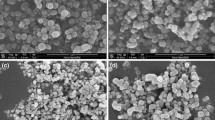Abstract
Gas chromatography is performed during the decomposition of barium titanyl-oxalate and the subsequent synthesis of barium titanate under nonisothermal conditions. It is shown that the path of the decomposition process is different under different heating conditions. A new mechanism of barium titanyl-oxalate decomposition and subsequent barium titanate synthesis under high heating rates is suggested. The change in mechanism is caused by barium titanyl-oxalate oxidation by free oxygen.
Similar content being viewed by others
References
A. V. Ragulya, O. O. Vasyl’kov, and V. V. Skorokhod, “Synthesis and sintering of nanocrystalline barium titanate under nonisothermal conditions. I. Control of barium titanate fineness during its synthesis from barium titanyl-oxalate,” Poroshk. Metall., Nos. 3–4, 59–65 (1997).
O. O. Vasyl’kiv, A. V. Ragulya and V. V. Skorokhod, “Synthesis and sintering of nanocrystalline barium titanate under nonisothermal conditions. II. Phase analysis of barium titanyl-oxalate decomposition products and synthesis of barium titanate,” Poroshk. Metall., Nos. 5–6, 53–59 (1997).
S. A. Maznichenko and Yu. A. Ryukhin, “Method for gas chromatographic separation and analysis of continuous gases,” Inventor’s Cert. 667888 USSR, Otkrytiya. Izobret., No. 22 (1979).
V. V. Kokhanovskii and M. M. Pavlyuchenko, “Study of the change in gaseous and solid product composition in the course of yttrium oxalate decomposition,” izv. Akad. Nauk BelSSR, Ser. Khim. Nauk., 78–83 (1975).
S. Kumar, G. Messing, and G. White, “Metal organic resin derived barium titanate: 1. Formation of barium titanium oxycarbonate intermediate,” J. Amer. Ceram. Soc.,76(3), 617–624 (1993).
J. P. Coutures, P. Odier, and P. Proust, “Barium titanate formation by organic resins formed with mixed citrate,” J. Mater. Sci.,27, 1849–1856 (1992).
Additional information
Materials Science Institute, Ukrainian Academy of Sciences, Kiev. Translated from Poroshkovaya Metallurgiya, Nos. 11–12, pp. 11–15 November–December, 1997.
Rights and permissions
About this article
Cite this article
Vasyl’kiv, O.O., Ragulya, A.V., Klimenko, V.P. et al. Synthesis and sintering of nanocrystalline barium titanate powder under nonisothermal conditions. III. Chromatographic analysis of barium titanyl-oxalate gaseous decomposition products. Powder Metall Met Ceram 36, 575–578 (1997). https://doi.org/10.1007/BF02676141
Received:
Issue Date:
DOI: https://doi.org/10.1007/BF02676141




